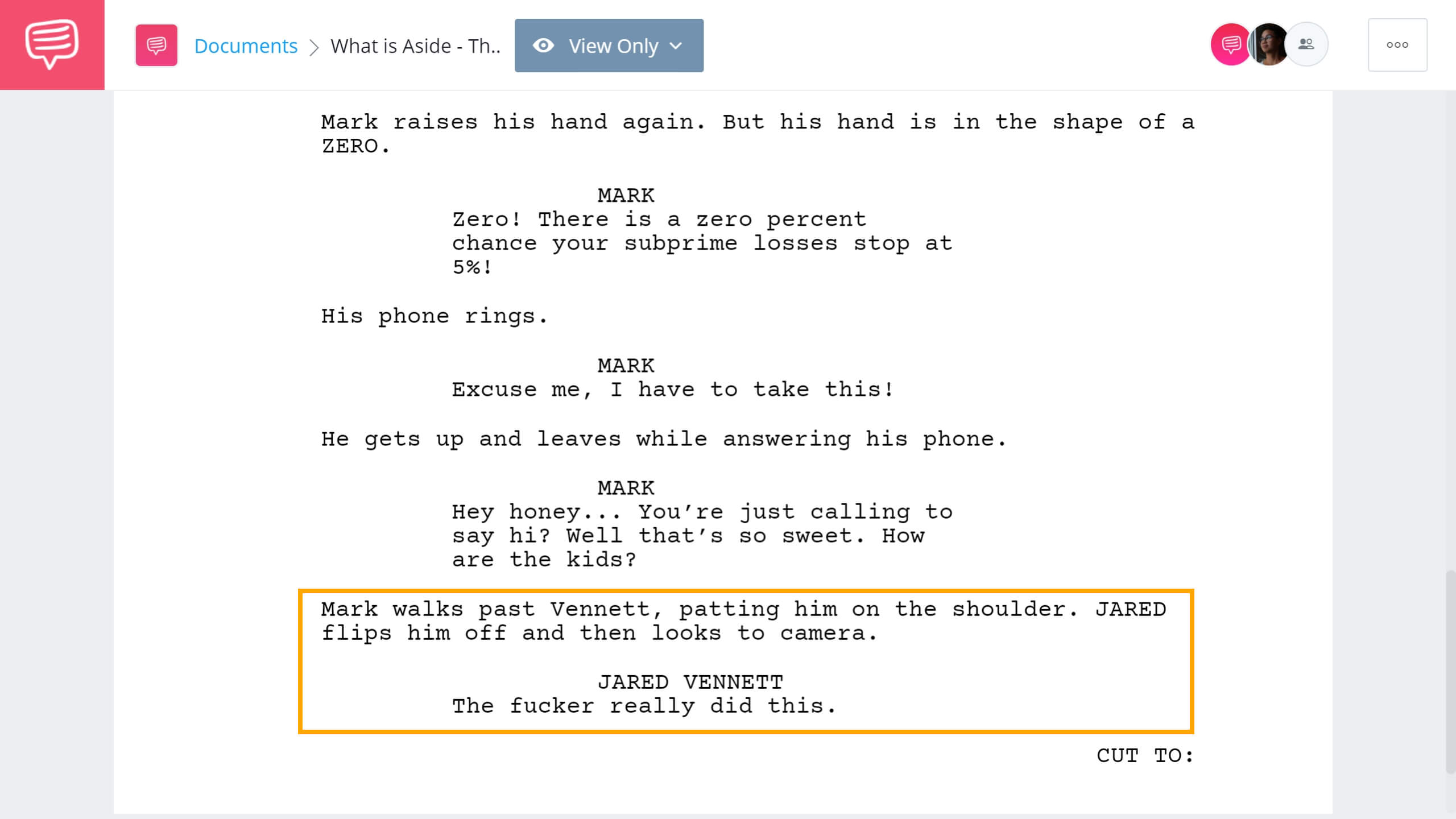Typically, films and television shows utilize dialogue and action to communicate information to an audience. But what if you want a character to speak directly to an audience? One of the best tools to do this is the aside. What is an aside in literature and film? Asides have been used in plays throughout history. This technique has inspired screenwriters to this day. In this article we’ll define aside and analyze a few modern examples.
What is an Aside in Literature?
First, let’s define aside
Some screenwriters like to preserve the division between the audience or reader and the world of their story. But in some cases, they can't resist creating a direct link between those worlds. One of the ways this is typically done is with asides. What is an aside in literature? Let’s first define aside so that we can distinguish it from other literary devices.
ASIDE DEFINITION LITERATURE
What is an aside in literature?
An aside is a speech or short comment that a character delivers directly to an audience. A key characteristic of an aside is that other characters on screen or on stage (in a play) appear not to hear the speech or comment. Asides or typically short. They are used to allow a character to comment on what is occurring in the story of the film or play. These comments can be reactions, opinions, secrets, or judgements.
What is an aside used for?
- Allows characters to comment on the story
- Reveals opinions or reactions of a character
- Connects an audience directly to a character
Aside meaning in literature
Soliloquy vs. aside
Another literary device that allows characters to speak directly to an audience is the soliloquy. Soliloquies are similar to asides in that they both allow a character to talk to themselves or directly to an audience without any other characters hearing. However, the two devices differ in a few ways.
A soliloquy is typically longer in length. It tends to reveal a character’s inner thoughts, internal conflict, and motives. A great example of this can be found in Les Miserables when Valjean delivers a soliloquy on his internal struggles.
Valjean's Soliloquy • Les Miserables
An aside, however, is typically a short comment. Asides typically are used to reveal a character's opinions or judgements on what is occurring in the story. Ferris Bueller’s Day Off uses asides throughout the film to connect the audience directly to what Ferris is thinking. In this scene, the director use an aside to allow Ferris to tell us what he thinks about their situation.
Ferris Bueller's Day Off • Aside examples
Now that we’ve clarified the difference between an aside and a soliloquy, let’s take a look at how an aside is used in both television and film.
Related Posts
Aside examples in television
Asides in House of Cards
One of the most influential writers of all time is none other than William Shakespeare. Shakespearean plays are filled with asides that allow antagonists or villains to gloat about their doings.
The television show House of Cards draws from Shakespeare in many ways.
Most distinctively, the show's use of asides gives the audience a window into the character Frank Underwood’s mind. Frank breaks the fourth wall and shares secrets, judgements, and opinions directly with the audience.
This video analysis by The Take further explains the Shakespearean influences in House of Cards and how asides are used to the show’s advantage.
House of Cards • Video Essay
House of Cards executes the difficult task of having the audience root for a rather evil character. How? By creating a direct line from Frank Underwood to the audience through asides. As Underwood shares his secret plans and opinions directly with us, we feel like we are in on the scheme.
Related Posts
Aside examples in film
Asides in The Big Short
Asides aren’t only used in television. Many films have made use of them aside to connect audiences to a film’s main character. In The Big Short, they are often used to inform or comment on what is occurring in the scene.
Since The Big Short is actually based on a true story, the film sometimes uses asides to clarify how events happened in real life. In this scene, an aside is used by Jared Vennett (played by Ryan Gosling) to highlight the fact that this actually happened in real life.
We brought The Big Short screenplay into StudioBinder’s free screenwriting software to take a look at how this aside is written.
Aside Example in The Big Short • Read Full Scene
Notice how the screenwriters clarify when a character looks into the camera. Asides break the fourth wall and allow characters to speak directly to the audience. Let’s see how this scene translates to the big screen.
The Big Short • Jared Vennett
The aside in this scene serves for both comedic effect and to inform the audience on the accuracy of the film’s portrayal to real life. This is a great example of how asides can be used creatively to serve a film’s story.
Analyzing how films and television shows utilize asides for different effects can help you as a filmmaker connect more directly to your audience. Sometimes, asides may not be the best choice for a film. But understanding how asides function is critical when making the decision to use them or not.
Related Posts
UP NEXT
Screenwriting Tips for Better Dialogue
Asides are a great storytelling device, but can be distracting for certain stories. If you’re looking for a less direct way to communicate ideas to your audience, check out our list of some of the best screenwriting tips for better dialogue.

